The Correspondence Between Digital Engineering and Project Management
VerifiedAdded on 2022/10/04
|14
|3454
|14
Report
AI Summary
This research proposal explores the impact of digital engineering technologies, including artificial intelligence (AI), virtual reality (VR), building information modeling (BIM), laser scanning (LS), and point cloud technology, on project management within the Australian construction industry. The study aims to investigate how these technologies influence project performance, the role of project managers in adopting digital engineering, and the benefits and challenges associated with their implementation. The methodology involves semi-structured interviews and action research to gather data on the expectations of project managers and changes in project management practices. The proposal highlights the need for digital transformation to enhance efficiency, reduce costs, and improve project delivery in the construction sector. The research questions address the impact of digital engineering adoption, performance improvements, benefits and challenges of various technologies, and project manager expectations to encourage wider implementation.

second draft proposal: the CORESPONDENEC BETWEEN digital engineering AND project
management
[Document subtitle]
management
[Document subtitle]
Paraphrase This Document
Need a fresh take? Get an instant paraphrase of this document with our AI Paraphraser
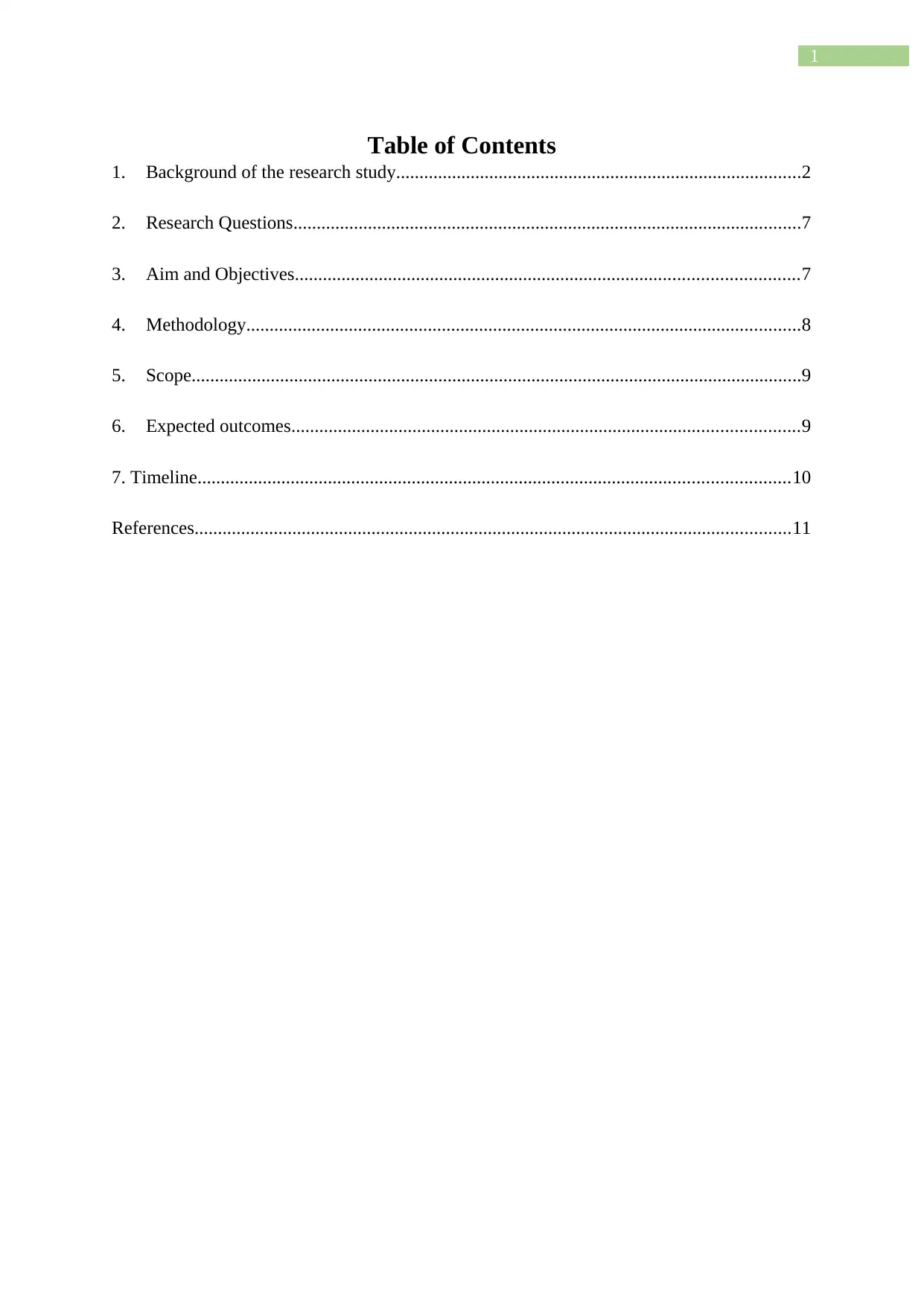
1
Table of Contents
1. Background of the research study.......................................................................................2
2. Research Questions.............................................................................................................7
3. Aim and Objectives............................................................................................................7
4. Methodology.......................................................................................................................8
5. Scope...................................................................................................................................9
6. Expected outcomes.............................................................................................................9
7. Timeline...............................................................................................................................10
References................................................................................................................................11
Table of Contents
1. Background of the research study.......................................................................................2
2. Research Questions.............................................................................................................7
3. Aim and Objectives............................................................................................................7
4. Methodology.......................................................................................................................8
5. Scope...................................................................................................................................9
6. Expected outcomes.............................................................................................................9
7. Timeline...............................................................................................................................10
References................................................................................................................................11
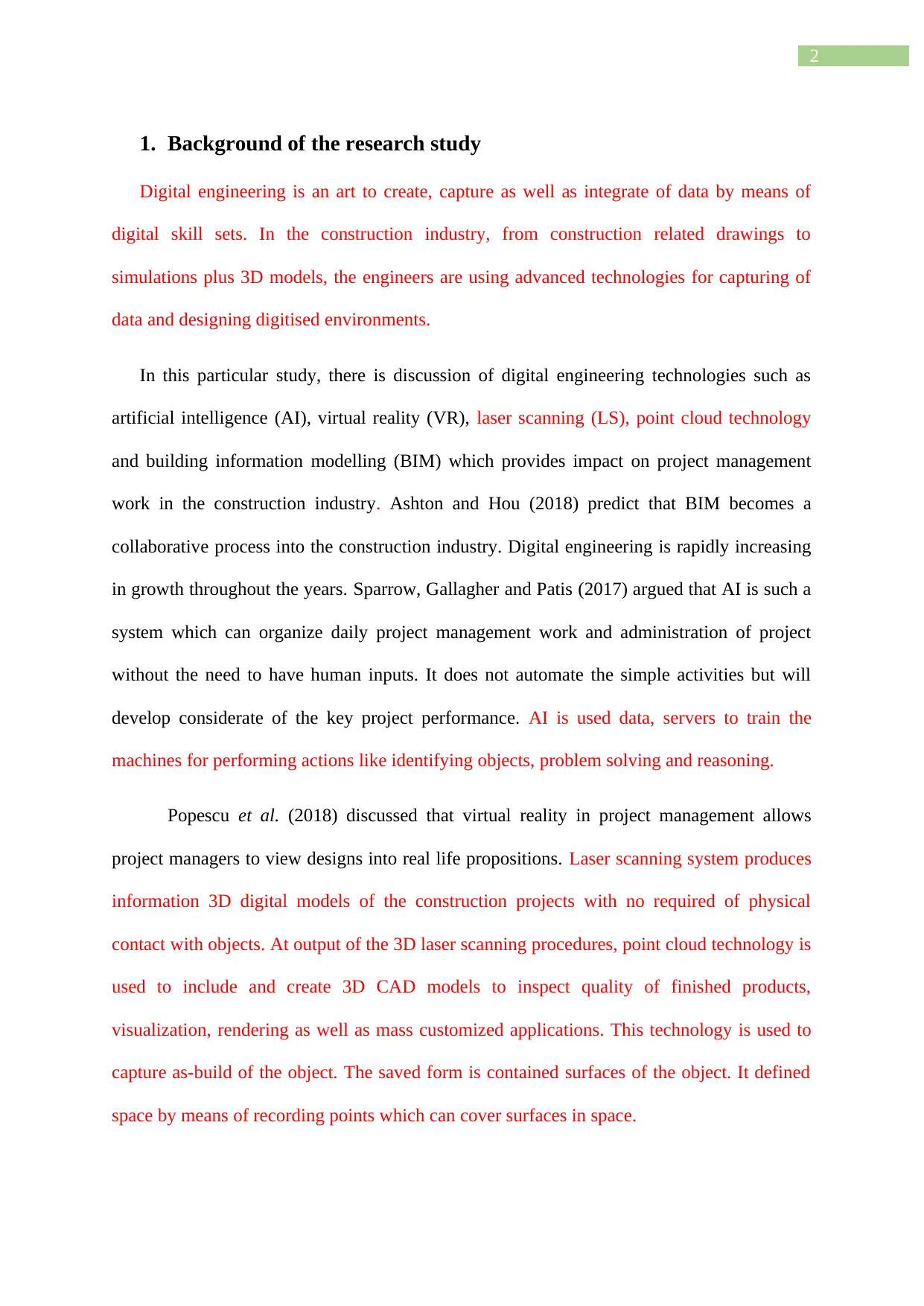
2
1. Background of the research study
Digital engineering is an art to create, capture as well as integrate of data by means of
digital skill sets. In the construction industry, from construction related drawings to
simulations plus 3D models, the engineers are using advanced technologies for capturing of
data and designing digitised environments.
In this particular study, there is discussion of digital engineering technologies such as
artificial intelligence (AI), virtual reality (VR), laser scanning (LS), point cloud technology
and building information modelling (BIM) which provides impact on project management
work in the construction industry. Ashton and Hou (2018) predict that BIM becomes a
collaborative process into the construction industry. Digital engineering is rapidly increasing
in growth throughout the years. Sparrow, Gallagher and Patis (2017) argued that AI is such a
system which can organize daily project management work and administration of project
without the need to have human inputs. It does not automate the simple activities but will
develop considerate of the key project performance. AI is used data, servers to train the
machines for performing actions like identifying objects, problem solving and reasoning.
Popescu et al. (2018) discussed that virtual reality in project management allows
project managers to view designs into real life propositions. Laser scanning system produces
information 3D digital models of the construction projects with no required of physical
contact with objects. At output of the 3D laser scanning procedures, point cloud technology is
used to include and create 3D CAD models to inspect quality of finished products,
visualization, rendering as well as mass customized applications. This technology is used to
capture as-build of the object. The saved form is contained surfaces of the object. It defined
space by means of recording points which can cover surfaces in space.
1. Background of the research study
Digital engineering is an art to create, capture as well as integrate of data by means of
digital skill sets. In the construction industry, from construction related drawings to
simulations plus 3D models, the engineers are using advanced technologies for capturing of
data and designing digitised environments.
In this particular study, there is discussion of digital engineering technologies such as
artificial intelligence (AI), virtual reality (VR), laser scanning (LS), point cloud technology
and building information modelling (BIM) which provides impact on project management
work in the construction industry. Ashton and Hou (2018) predict that BIM becomes a
collaborative process into the construction industry. Digital engineering is rapidly increasing
in growth throughout the years. Sparrow, Gallagher and Patis (2017) argued that AI is such a
system which can organize daily project management work and administration of project
without the need to have human inputs. It does not automate the simple activities but will
develop considerate of the key project performance. AI is used data, servers to train the
machines for performing actions like identifying objects, problem solving and reasoning.
Popescu et al. (2018) discussed that virtual reality in project management allows
project managers to view designs into real life propositions. Laser scanning system produces
information 3D digital models of the construction projects with no required of physical
contact with objects. At output of the 3D laser scanning procedures, point cloud technology is
used to include and create 3D CAD models to inspect quality of finished products,
visualization, rendering as well as mass customized applications. This technology is used to
capture as-build of the object. The saved form is contained surfaces of the object. It defined
space by means of recording points which can cover surfaces in space.
⊘ This is a preview!⊘
Do you want full access?
Subscribe today to unlock all pages.

Trusted by 1+ million students worldwide
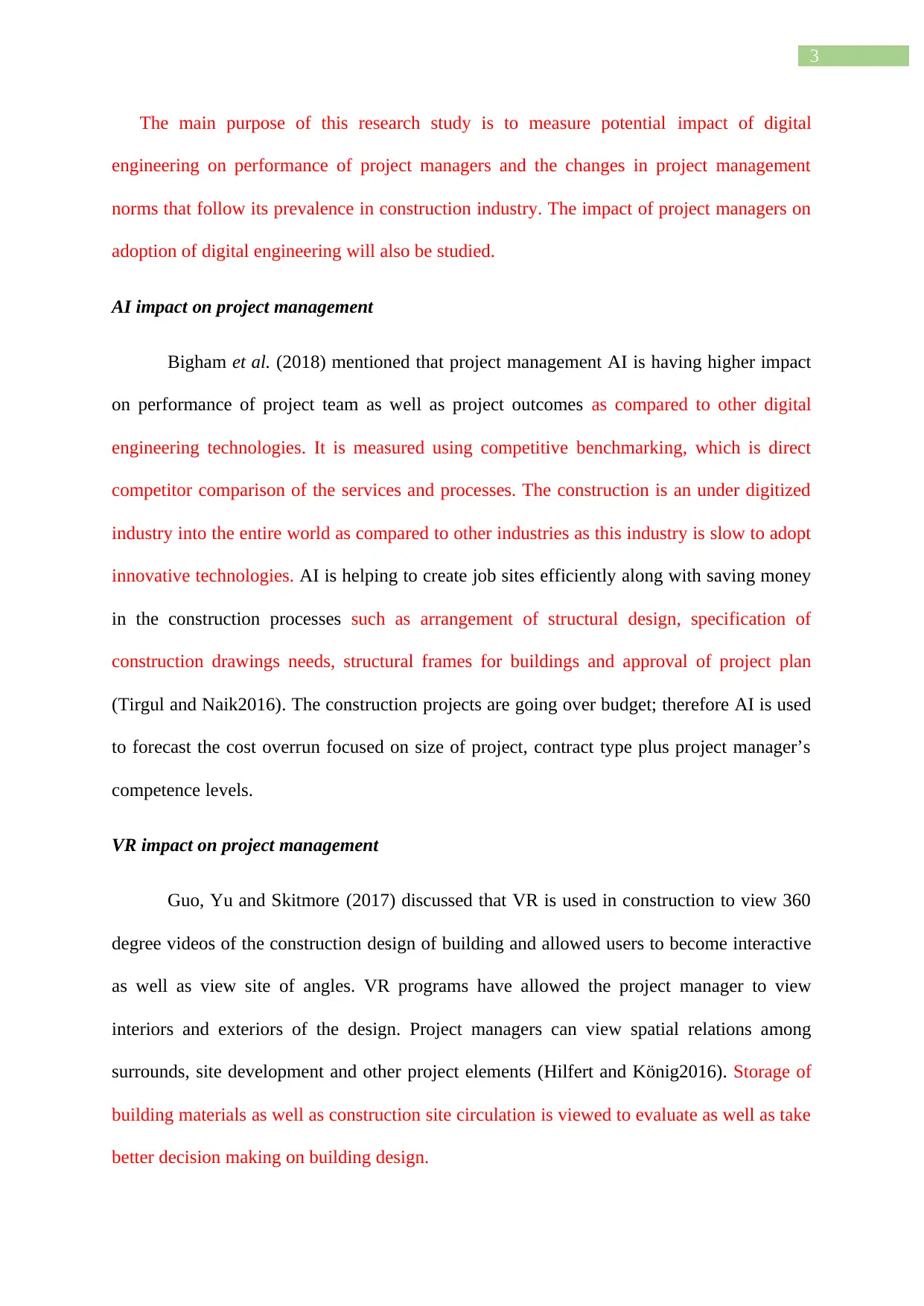
3
The main purpose of this research study is to measure potential impact of digital
engineering on performance of project managers and the changes in project management
norms that follow its prevalence in construction industry. The impact of project managers on
adoption of digital engineering will also be studied.
AI impact on project management
Bigham et al. (2018) mentioned that project management AI is having higher impact
on performance of project team as well as project outcomes as compared to other digital
engineering technologies. It is measured using competitive benchmarking, which is direct
competitor comparison of the services and processes. The construction is an under digitized
industry into the entire world as compared to other industries as this industry is slow to adopt
innovative technologies. AI is helping to create job sites efficiently along with saving money
in the construction processes such as arrangement of structural design, specification of
construction drawings needs, structural frames for buildings and approval of project plan
(Tirgul and Naik2016). The construction projects are going over budget; therefore AI is used
to forecast the cost overrun focused on size of project, contract type plus project manager’s
competence levels.
VR impact on project management
Guo, Yu and Skitmore (2017) discussed that VR is used in construction to view 360
degree videos of the construction design of building and allowed users to become interactive
as well as view site of angles. VR programs have allowed the project manager to view
interiors and exteriors of the design. Project managers can view spatial relations among
surrounds, site development and other project elements (Hilfert and König2016). Storage of
building materials as well as construction site circulation is viewed to evaluate as well as take
better decision making on building design.
The main purpose of this research study is to measure potential impact of digital
engineering on performance of project managers and the changes in project management
norms that follow its prevalence in construction industry. The impact of project managers on
adoption of digital engineering will also be studied.
AI impact on project management
Bigham et al. (2018) mentioned that project management AI is having higher impact
on performance of project team as well as project outcomes as compared to other digital
engineering technologies. It is measured using competitive benchmarking, which is direct
competitor comparison of the services and processes. The construction is an under digitized
industry into the entire world as compared to other industries as this industry is slow to adopt
innovative technologies. AI is helping to create job sites efficiently along with saving money
in the construction processes such as arrangement of structural design, specification of
construction drawings needs, structural frames for buildings and approval of project plan
(Tirgul and Naik2016). The construction projects are going over budget; therefore AI is used
to forecast the cost overrun focused on size of project, contract type plus project manager’s
competence levels.
VR impact on project management
Guo, Yu and Skitmore (2017) discussed that VR is used in construction to view 360
degree videos of the construction design of building and allowed users to become interactive
as well as view site of angles. VR programs have allowed the project manager to view
interiors and exteriors of the design. Project managers can view spatial relations among
surrounds, site development and other project elements (Hilfert and König2016). Storage of
building materials as well as construction site circulation is viewed to evaluate as well as take
better decision making on building design.
Paraphrase This Document
Need a fresh take? Get an instant paraphrase of this document with our AI Paraphraser
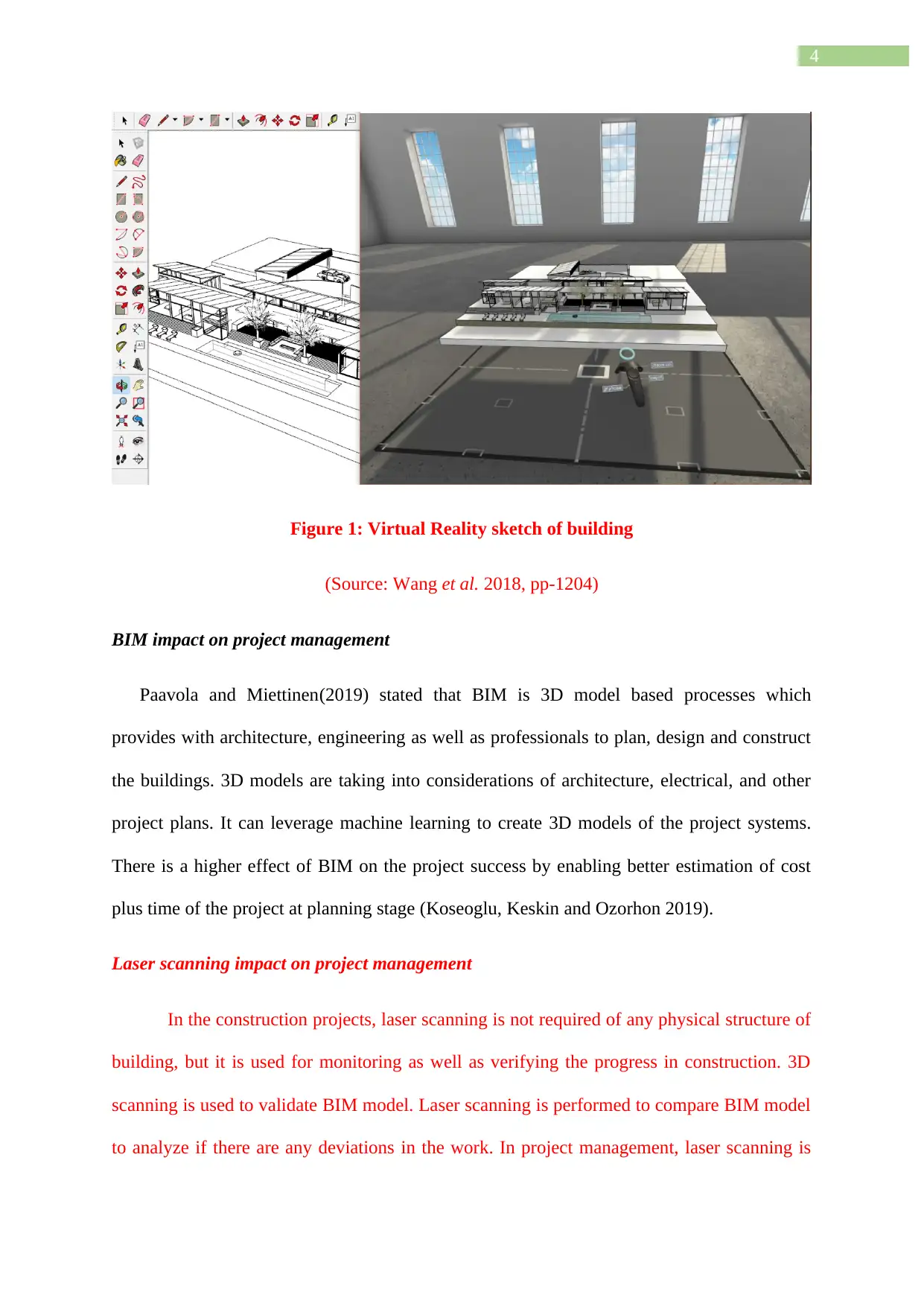
4
Figure 1: Virtual Reality sketch of building
(Source: Wang et al. 2018, pp-1204)
BIM impact on project management
Paavola and Miettinen(2019) stated that BIM is 3D model based processes which
provides with architecture, engineering as well as professionals to plan, design and construct
the buildings. 3D models are taking into considerations of architecture, electrical, and other
project plans. It can leverage machine learning to create 3D models of the project systems.
There is a higher effect of BIM on the project success by enabling better estimation of cost
plus time of the project at planning stage (Koseoglu, Keskin and Ozorhon 2019).
Laser scanning impact on project management
In the construction projects, laser scanning is not required of any physical structure of
building, but it is used for monitoring as well as verifying the progress in construction. 3D
scanning is used to validate BIM model. Laser scanning is performed to compare BIM model
to analyze if there are any deviations in the work. In project management, laser scanning is
Figure 1: Virtual Reality sketch of building
(Source: Wang et al. 2018, pp-1204)
BIM impact on project management
Paavola and Miettinen(2019) stated that BIM is 3D model based processes which
provides with architecture, engineering as well as professionals to plan, design and construct
the buildings. 3D models are taking into considerations of architecture, electrical, and other
project plans. It can leverage machine learning to create 3D models of the project systems.
There is a higher effect of BIM on the project success by enabling better estimation of cost
plus time of the project at planning stage (Koseoglu, Keskin and Ozorhon 2019).
Laser scanning impact on project management
In the construction projects, laser scanning is not required of any physical structure of
building, but it is used for monitoring as well as verifying the progress in construction. 3D
scanning is used to validate BIM model. Laser scanning is performed to compare BIM model
to analyze if there are any deviations in the work. In project management, laser scanning is
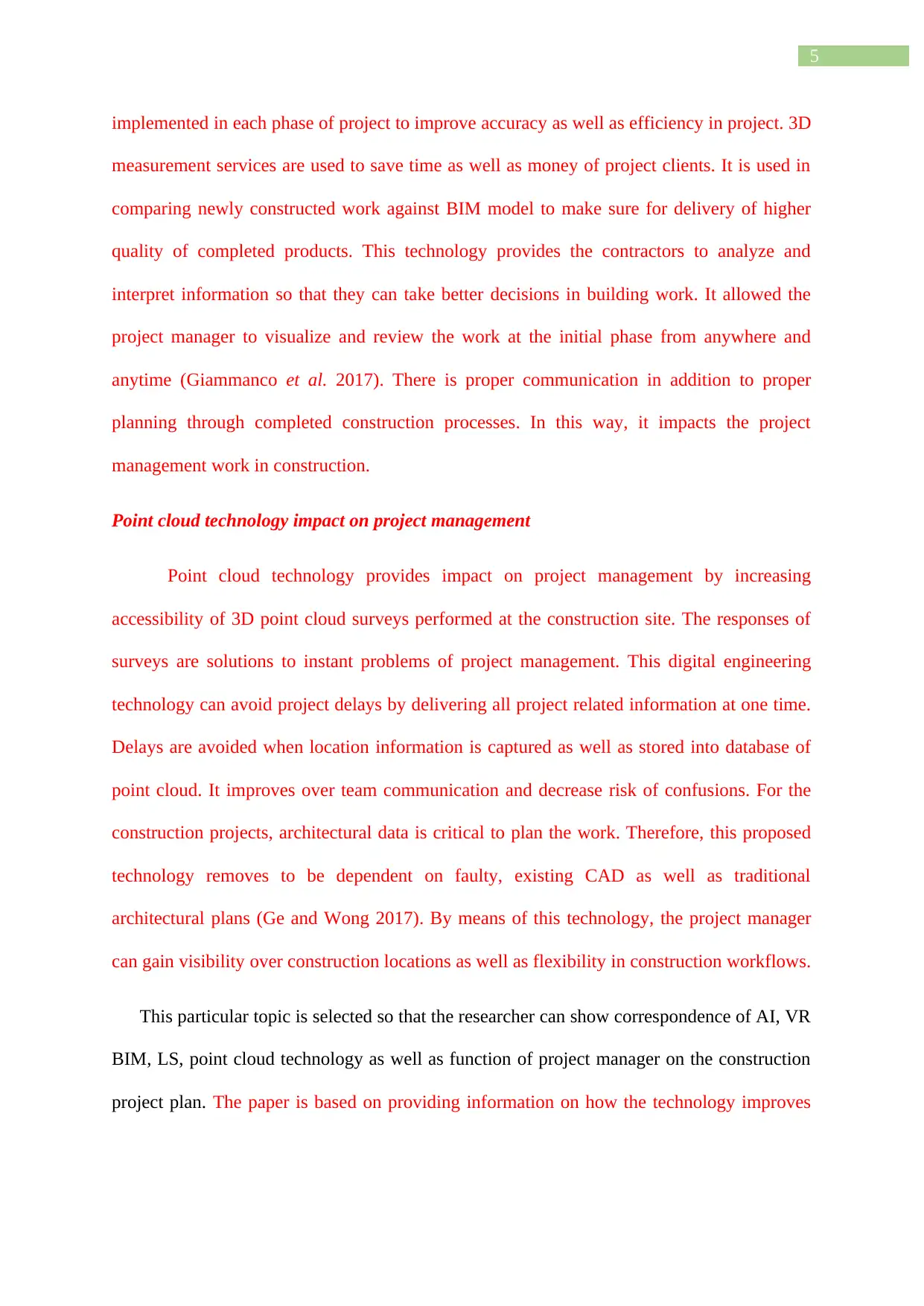
5
implemented in each phase of project to improve accuracy as well as efficiency in project. 3D
measurement services are used to save time as well as money of project clients. It is used in
comparing newly constructed work against BIM model to make sure for delivery of higher
quality of completed products. This technology provides the contractors to analyze and
interpret information so that they can take better decisions in building work. It allowed the
project manager to visualize and review the work at the initial phase from anywhere and
anytime (Giammanco et al. 2017). There is proper communication in addition to proper
planning through completed construction processes. In this way, it impacts the project
management work in construction.
Point cloud technology impact on project management
Point cloud technology provides impact on project management by increasing
accessibility of 3D point cloud surveys performed at the construction site. The responses of
surveys are solutions to instant problems of project management. This digital engineering
technology can avoid project delays by delivering all project related information at one time.
Delays are avoided when location information is captured as well as stored into database of
point cloud. It improves over team communication and decrease risk of confusions. For the
construction projects, architectural data is critical to plan the work. Therefore, this proposed
technology removes to be dependent on faulty, existing CAD as well as traditional
architectural plans (Ge and Wong 2017). By means of this technology, the project manager
can gain visibility over construction locations as well as flexibility in construction workflows.
This particular topic is selected so that the researcher can show correspondence of AI, VR
BIM, LS, point cloud technology as well as function of project manager on the construction
project plan. The paper is based on providing information on how the technology improves
implemented in each phase of project to improve accuracy as well as efficiency in project. 3D
measurement services are used to save time as well as money of project clients. It is used in
comparing newly constructed work against BIM model to make sure for delivery of higher
quality of completed products. This technology provides the contractors to analyze and
interpret information so that they can take better decisions in building work. It allowed the
project manager to visualize and review the work at the initial phase from anywhere and
anytime (Giammanco et al. 2017). There is proper communication in addition to proper
planning through completed construction processes. In this way, it impacts the project
management work in construction.
Point cloud technology impact on project management
Point cloud technology provides impact on project management by increasing
accessibility of 3D point cloud surveys performed at the construction site. The responses of
surveys are solutions to instant problems of project management. This digital engineering
technology can avoid project delays by delivering all project related information at one time.
Delays are avoided when location information is captured as well as stored into database of
point cloud. It improves over team communication and decrease risk of confusions. For the
construction projects, architectural data is critical to plan the work. Therefore, this proposed
technology removes to be dependent on faulty, existing CAD as well as traditional
architectural plans (Ge and Wong 2017). By means of this technology, the project manager
can gain visibility over construction locations as well as flexibility in construction workflows.
This particular topic is selected so that the researcher can show correspondence of AI, VR
BIM, LS, point cloud technology as well as function of project manager on the construction
project plan. The paper is based on providing information on how the technology improves
⊘ This is a preview!⊘
Do you want full access?
Subscribe today to unlock all pages.

Trusted by 1+ million students worldwide
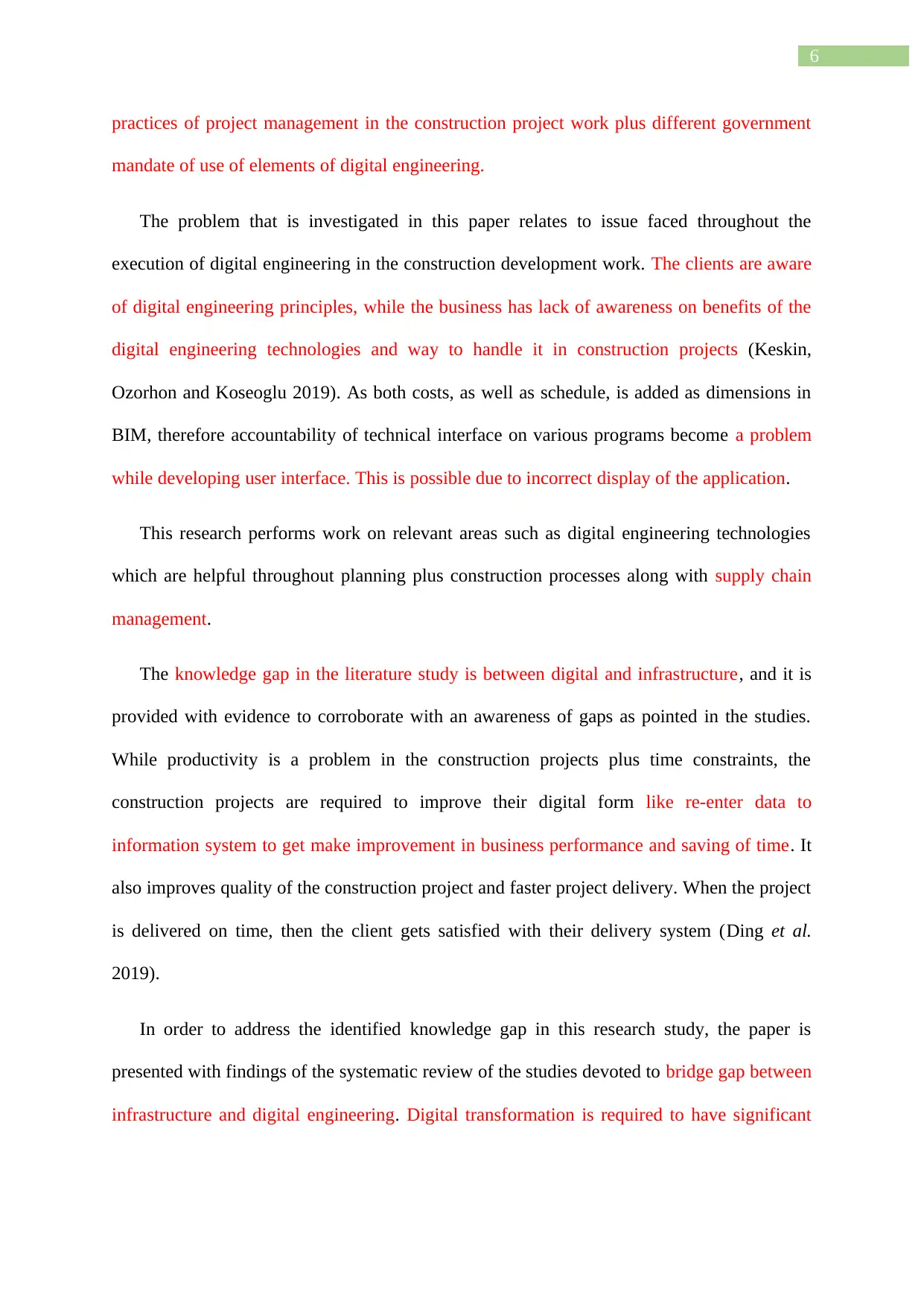
6
practices of project management in the construction project work plus different government
mandate of use of elements of digital engineering.
The problem that is investigated in this paper relates to issue faced throughout the
execution of digital engineering in the construction development work. The clients are aware
of digital engineering principles, while the business has lack of awareness on benefits of the
digital engineering technologies and way to handle it in construction projects (Keskin,
Ozorhon and Koseoglu 2019). As both costs, as well as schedule, is added as dimensions in
BIM, therefore accountability of technical interface on various programs become a problem
while developing user interface. This is possible due to incorrect display of the application.
This research performs work on relevant areas such as digital engineering technologies
which are helpful throughout planning plus construction processes along with supply chain
management.
The knowledge gap in the literature study is between digital and infrastructure, and it is
provided with evidence to corroborate with an awareness of gaps as pointed in the studies.
While productivity is a problem in the construction projects plus time constraints, the
construction projects are required to improve their digital form like re-enter data to
information system to get make improvement in business performance and saving of time. It
also improves quality of the construction project and faster project delivery. When the project
is delivered on time, then the client gets satisfied with their delivery system (Ding et al.
2019).
In order to address the identified knowledge gap in this research study, the paper is
presented with findings of the systematic review of the studies devoted to bridge gap between
infrastructure and digital engineering. Digital transformation is required to have significant
practices of project management in the construction project work plus different government
mandate of use of elements of digital engineering.
The problem that is investigated in this paper relates to issue faced throughout the
execution of digital engineering in the construction development work. The clients are aware
of digital engineering principles, while the business has lack of awareness on benefits of the
digital engineering technologies and way to handle it in construction projects (Keskin,
Ozorhon and Koseoglu 2019). As both costs, as well as schedule, is added as dimensions in
BIM, therefore accountability of technical interface on various programs become a problem
while developing user interface. This is possible due to incorrect display of the application.
This research performs work on relevant areas such as digital engineering technologies
which are helpful throughout planning plus construction processes along with supply chain
management.
The knowledge gap in the literature study is between digital and infrastructure, and it is
provided with evidence to corroborate with an awareness of gaps as pointed in the studies.
While productivity is a problem in the construction projects plus time constraints, the
construction projects are required to improve their digital form like re-enter data to
information system to get make improvement in business performance and saving of time. It
also improves quality of the construction project and faster project delivery. When the project
is delivered on time, then the client gets satisfied with their delivery system (Ding et al.
2019).
In order to address the identified knowledge gap in this research study, the paper is
presented with findings of the systematic review of the studies devoted to bridge gap between
infrastructure and digital engineering. Digital transformation is required to have significant
Paraphrase This Document
Need a fresh take? Get an instant paraphrase of this document with our AI Paraphraser
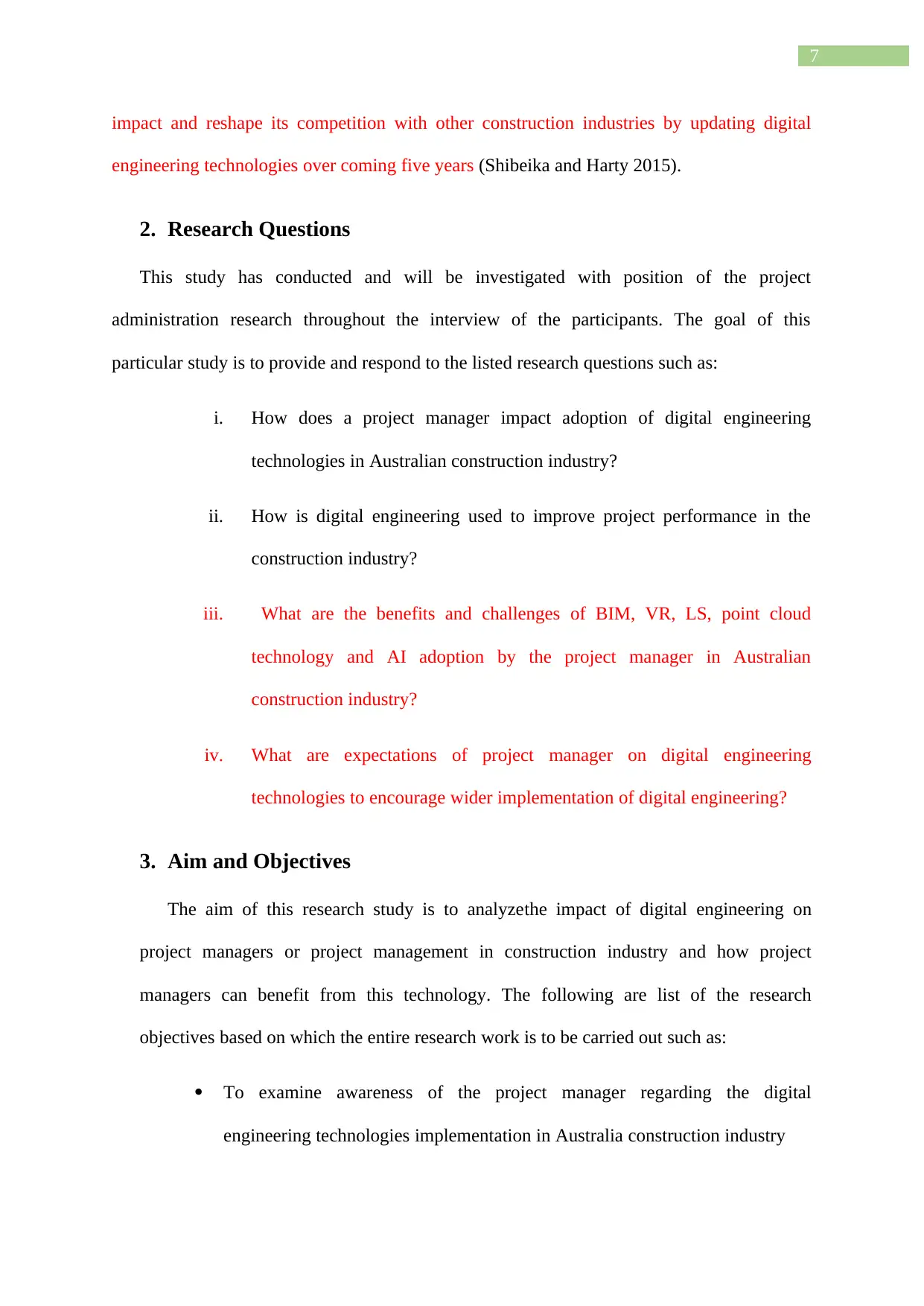
7
impact and reshape its competition with other construction industries by updating digital
engineering technologies over coming five years (Shibeika and Harty 2015).
2. Research Questions
This study has conducted and will be investigated with position of the project
administration research throughout the interview of the participants. The goal of this
particular study is to provide and respond to the listed research questions such as:
i. How does a project manager impact adoption of digital engineering
technologies in Australian construction industry?
ii. How is digital engineering used to improve project performance in the
construction industry?
iii. What are the benefits and challenges of BIM, VR, LS, point cloud
technology and AI adoption by the project manager in Australian
construction industry?
iv. What are expectations of project manager on digital engineering
technologies to encourage wider implementation of digital engineering?
3. Aim and Objectives
The aim of this research study is to analyzethe impact of digital engineering on
project managers or project management in construction industry and how project
managers can benefit from this technology. The following are list of the research
objectives based on which the entire research work is to be carried out such as:
To examine awareness of the project manager regarding the digital
engineering technologies implementation in Australia construction industry
impact and reshape its competition with other construction industries by updating digital
engineering technologies over coming five years (Shibeika and Harty 2015).
2. Research Questions
This study has conducted and will be investigated with position of the project
administration research throughout the interview of the participants. The goal of this
particular study is to provide and respond to the listed research questions such as:
i. How does a project manager impact adoption of digital engineering
technologies in Australian construction industry?
ii. How is digital engineering used to improve project performance in the
construction industry?
iii. What are the benefits and challenges of BIM, VR, LS, point cloud
technology and AI adoption by the project manager in Australian
construction industry?
iv. What are expectations of project manager on digital engineering
technologies to encourage wider implementation of digital engineering?
3. Aim and Objectives
The aim of this research study is to analyzethe impact of digital engineering on
project managers or project management in construction industry and how project
managers can benefit from this technology. The following are list of the research
objectives based on which the entire research work is to be carried out such as:
To examine awareness of the project manager regarding the digital
engineering technologies implementation in Australia construction industry
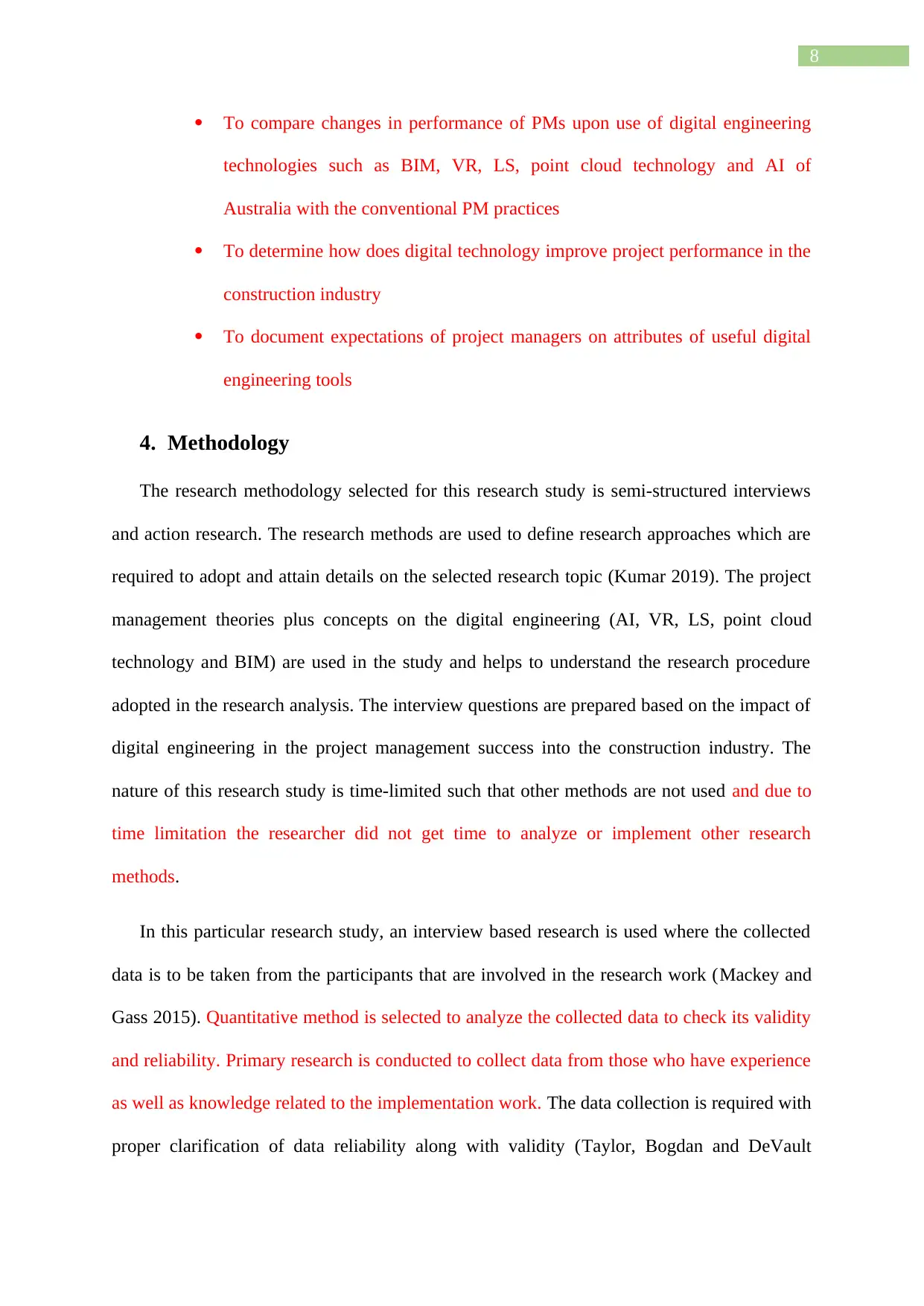
8
To compare changes in performance of PMs upon use of digital engineering
technologies such as BIM, VR, LS, point cloud technology and AI of
Australia with the conventional PM practices
To determine how does digital technology improve project performance in the
construction industry
To document expectations of project managers on attributes of useful digital
engineering tools
4. Methodology
The research methodology selected for this research study is semi-structured interviews
and action research. The research methods are used to define research approaches which are
required to adopt and attain details on the selected research topic (Kumar 2019). The project
management theories plus concepts on the digital engineering (AI, VR, LS, point cloud
technology and BIM) are used in the study and helps to understand the research procedure
adopted in the research analysis. The interview questions are prepared based on the impact of
digital engineering in the project management success into the construction industry. The
nature of this research study is time-limited such that other methods are not used and due to
time limitation the researcher did not get time to analyze or implement other research
methods.
In this particular research study, an interview based research is used where the collected
data is to be taken from the participants that are involved in the research work (Mackey and
Gass 2015). Quantitative method is selected to analyze the collected data to check its validity
and reliability. Primary research is conducted to collect data from those who have experience
as well as knowledge related to the implementation work. The data collection is required with
proper clarification of data reliability along with validity (Taylor, Bogdan and DeVault
To compare changes in performance of PMs upon use of digital engineering
technologies such as BIM, VR, LS, point cloud technology and AI of
Australia with the conventional PM practices
To determine how does digital technology improve project performance in the
construction industry
To document expectations of project managers on attributes of useful digital
engineering tools
4. Methodology
The research methodology selected for this research study is semi-structured interviews
and action research. The research methods are used to define research approaches which are
required to adopt and attain details on the selected research topic (Kumar 2019). The project
management theories plus concepts on the digital engineering (AI, VR, LS, point cloud
technology and BIM) are used in the study and helps to understand the research procedure
adopted in the research analysis. The interview questions are prepared based on the impact of
digital engineering in the project management success into the construction industry. The
nature of this research study is time-limited such that other methods are not used and due to
time limitation the researcher did not get time to analyze or implement other research
methods.
In this particular research study, an interview based research is used where the collected
data is to be taken from the participants that are involved in the research work (Mackey and
Gass 2015). Quantitative method is selected to analyze the collected data to check its validity
and reliability. Primary research is conducted to collect data from those who have experience
as well as knowledge related to the implementation work. The data collection is required with
proper clarification of data reliability along with validity (Taylor, Bogdan and DeVault
⊘ This is a preview!⊘
Do you want full access?
Subscribe today to unlock all pages.

Trusted by 1+ million students worldwide
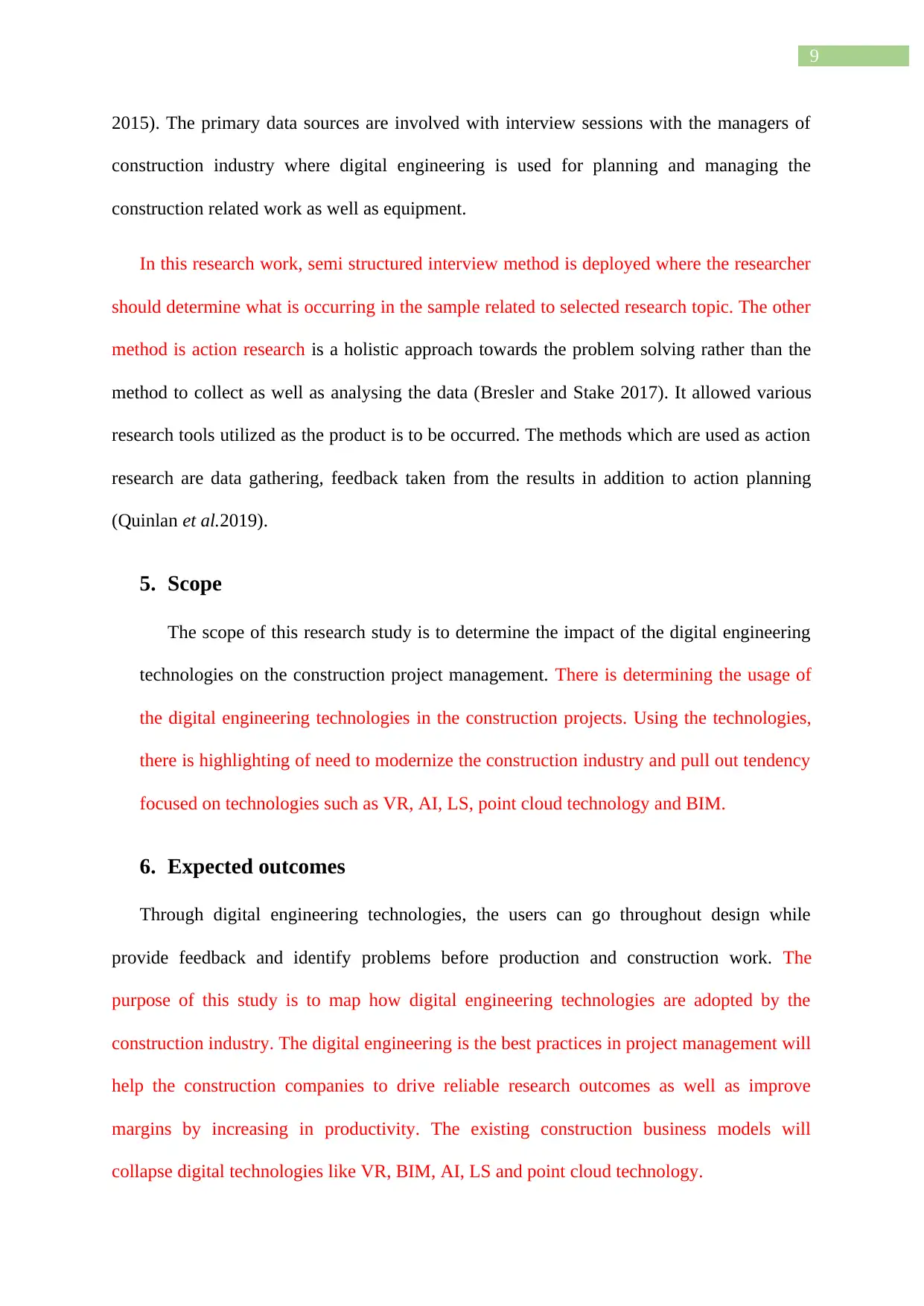
9
2015). The primary data sources are involved with interview sessions with the managers of
construction industry where digital engineering is used for planning and managing the
construction related work as well as equipment.
In this research work, semi structured interview method is deployed where the researcher
should determine what is occurring in the sample related to selected research topic. The other
method is action research is a holistic approach towards the problem solving rather than the
method to collect as well as analysing the data (Bresler and Stake 2017). It allowed various
research tools utilized as the product is to be occurred. The methods which are used as action
research are data gathering, feedback taken from the results in addition to action planning
(Quinlan et al.2019).
5. Scope
The scope of this research study is to determine the impact of the digital engineering
technologies on the construction project management. There is determining the usage of
the digital engineering technologies in the construction projects. Using the technologies,
there is highlighting of need to modernize the construction industry and pull out tendency
focused on technologies such as VR, AI, LS, point cloud technology and BIM.
6. Expected outcomes
Through digital engineering technologies, the users can go throughout design while
provide feedback and identify problems before production and construction work. The
purpose of this study is to map how digital engineering technologies are adopted by the
construction industry. The digital engineering is the best practices in project management will
help the construction companies to drive reliable research outcomes as well as improve
margins by increasing in productivity. The existing construction business models will
collapse digital technologies like VR, BIM, AI, LS and point cloud technology.
2015). The primary data sources are involved with interview sessions with the managers of
construction industry where digital engineering is used for planning and managing the
construction related work as well as equipment.
In this research work, semi structured interview method is deployed where the researcher
should determine what is occurring in the sample related to selected research topic. The other
method is action research is a holistic approach towards the problem solving rather than the
method to collect as well as analysing the data (Bresler and Stake 2017). It allowed various
research tools utilized as the product is to be occurred. The methods which are used as action
research are data gathering, feedback taken from the results in addition to action planning
(Quinlan et al.2019).
5. Scope
The scope of this research study is to determine the impact of the digital engineering
technologies on the construction project management. There is determining the usage of
the digital engineering technologies in the construction projects. Using the technologies,
there is highlighting of need to modernize the construction industry and pull out tendency
focused on technologies such as VR, AI, LS, point cloud technology and BIM.
6. Expected outcomes
Through digital engineering technologies, the users can go throughout design while
provide feedback and identify problems before production and construction work. The
purpose of this study is to map how digital engineering technologies are adopted by the
construction industry. The digital engineering is the best practices in project management will
help the construction companies to drive reliable research outcomes as well as improve
margins by increasing in productivity. The existing construction business models will
collapse digital technologies like VR, BIM, AI, LS and point cloud technology.
Paraphrase This Document
Need a fresh take? Get an instant paraphrase of this document with our AI Paraphraser
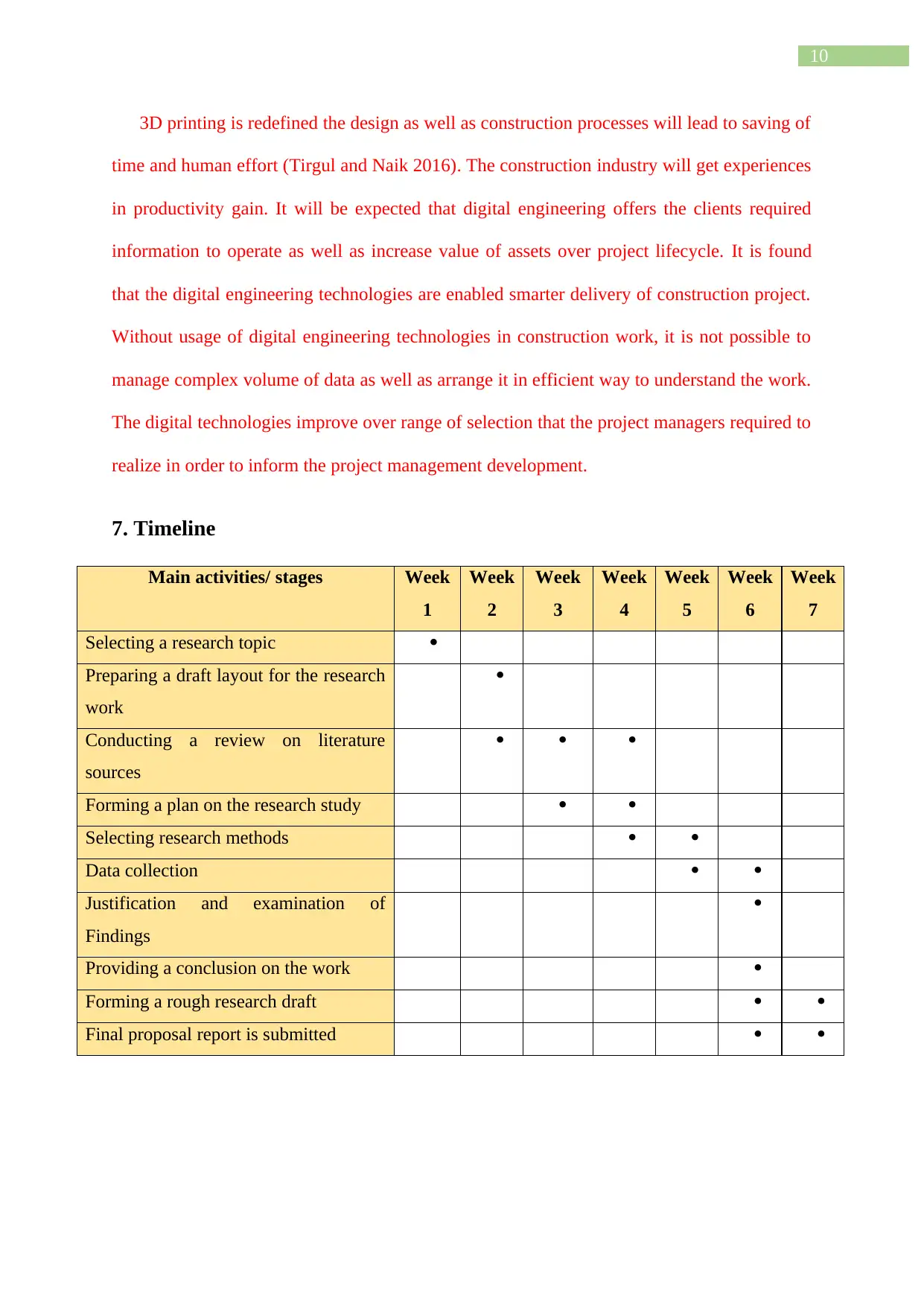
10
3D printing is redefined the design as well as construction processes will lead to saving of
time and human effort (Tirgul and Naik 2016). The construction industry will get experiences
in productivity gain. It will be expected that digital engineering offers the clients required
information to operate as well as increase value of assets over project lifecycle. It is found
that the digital engineering technologies are enabled smarter delivery of construction project.
Without usage of digital engineering technologies in construction work, it is not possible to
manage complex volume of data as well as arrange it in efficient way to understand the work.
The digital technologies improve over range of selection that the project managers required to
realize in order to inform the project management development.
7. Timeline
Main activities/ stages Week
1
Week
2
Week
3
Week
4
Week
5
Week
6
Week
7
Selecting a research topic
Preparing a draft layout for the research
work
Conducting a review on literature
sources
Forming a plan on the research study
Selecting research methods
Data collection
Justification and examination of
Findings
Providing a conclusion on the work
Forming a rough research draft
Final proposal report is submitted
3D printing is redefined the design as well as construction processes will lead to saving of
time and human effort (Tirgul and Naik 2016). The construction industry will get experiences
in productivity gain. It will be expected that digital engineering offers the clients required
information to operate as well as increase value of assets over project lifecycle. It is found
that the digital engineering technologies are enabled smarter delivery of construction project.
Without usage of digital engineering technologies in construction work, it is not possible to
manage complex volume of data as well as arrange it in efficient way to understand the work.
The digital technologies improve over range of selection that the project managers required to
realize in order to inform the project management development.
7. Timeline
Main activities/ stages Week
1
Week
2
Week
3
Week
4
Week
5
Week
6
Week
7
Selecting a research topic
Preparing a draft layout for the research
work
Conducting a review on literature
sources
Forming a plan on the research study
Selecting research methods
Data collection
Justification and examination of
Findings
Providing a conclusion on the work
Forming a rough research draft
Final proposal report is submitted
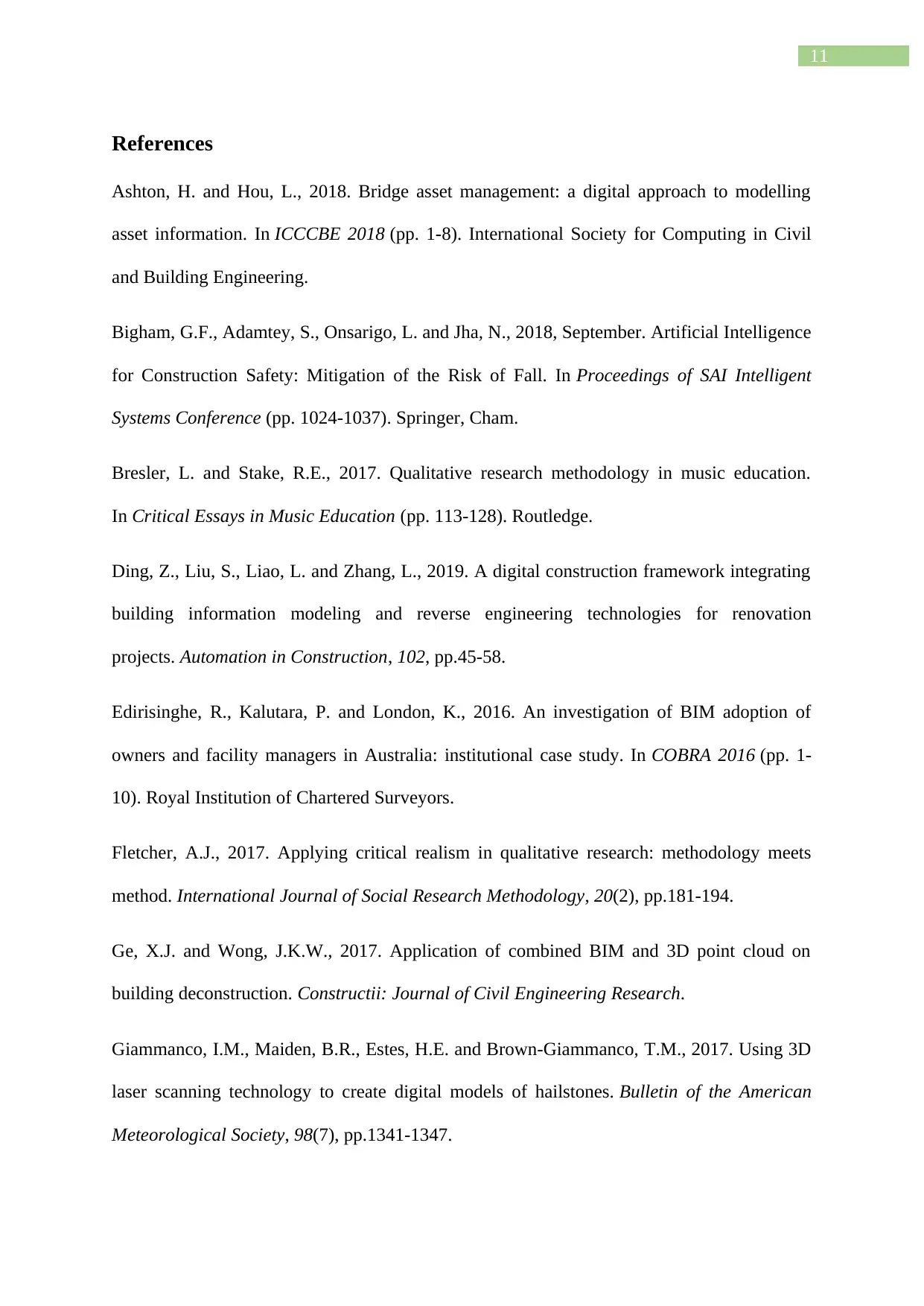
11
References
Ashton, H. and Hou, L., 2018. Bridge asset management: a digital approach to modelling
asset information. In ICCCBE 2018 (pp. 1-8). International Society for Computing in Civil
and Building Engineering.
Bigham, G.F., Adamtey, S., Onsarigo, L. and Jha, N., 2018, September. Artificial Intelligence
for Construction Safety: Mitigation of the Risk of Fall. In Proceedings of SAI Intelligent
Systems Conference (pp. 1024-1037). Springer, Cham.
Bresler, L. and Stake, R.E., 2017. Qualitative research methodology in music education.
In Critical Essays in Music Education (pp. 113-128). Routledge.
Ding, Z., Liu, S., Liao, L. and Zhang, L., 2019. A digital construction framework integrating
building information modeling and reverse engineering technologies for renovation
projects. Automation in Construction, 102, pp.45-58.
Edirisinghe, R., Kalutara, P. and London, K., 2016. An investigation of BIM adoption of
owners and facility managers in Australia: institutional case study. In COBRA 2016 (pp. 1-
10). Royal Institution of Chartered Surveyors.
Fletcher, A.J., 2017. Applying critical realism in qualitative research: methodology meets
method. International Journal of Social Research Methodology, 20(2), pp.181-194.
Ge, X.J. and Wong, J.K.W., 2017. Application of combined BIM and 3D point cloud on
building deconstruction. Constructii: Journal of Civil Engineering Research.
Giammanco, I.M., Maiden, B.R., Estes, H.E. and Brown-Giammanco, T.M., 2017. Using 3D
laser scanning technology to create digital models of hailstones. Bulletin of the American
Meteorological Society, 98(7), pp.1341-1347.
References
Ashton, H. and Hou, L., 2018. Bridge asset management: a digital approach to modelling
asset information. In ICCCBE 2018 (pp. 1-8). International Society for Computing in Civil
and Building Engineering.
Bigham, G.F., Adamtey, S., Onsarigo, L. and Jha, N., 2018, September. Artificial Intelligence
for Construction Safety: Mitigation of the Risk of Fall. In Proceedings of SAI Intelligent
Systems Conference (pp. 1024-1037). Springer, Cham.
Bresler, L. and Stake, R.E., 2017. Qualitative research methodology in music education.
In Critical Essays in Music Education (pp. 113-128). Routledge.
Ding, Z., Liu, S., Liao, L. and Zhang, L., 2019. A digital construction framework integrating
building information modeling and reverse engineering technologies for renovation
projects. Automation in Construction, 102, pp.45-58.
Edirisinghe, R., Kalutara, P. and London, K., 2016. An investigation of BIM adoption of
owners and facility managers in Australia: institutional case study. In COBRA 2016 (pp. 1-
10). Royal Institution of Chartered Surveyors.
Fletcher, A.J., 2017. Applying critical realism in qualitative research: methodology meets
method. International Journal of Social Research Methodology, 20(2), pp.181-194.
Ge, X.J. and Wong, J.K.W., 2017. Application of combined BIM and 3D point cloud on
building deconstruction. Constructii: Journal of Civil Engineering Research.
Giammanco, I.M., Maiden, B.R., Estes, H.E. and Brown-Giammanco, T.M., 2017. Using 3D
laser scanning technology to create digital models of hailstones. Bulletin of the American
Meteorological Society, 98(7), pp.1341-1347.
⊘ This is a preview!⊘
Do you want full access?
Subscribe today to unlock all pages.

Trusted by 1+ million students worldwide
1 out of 14
Related Documents
Your All-in-One AI-Powered Toolkit for Academic Success.
+13062052269
info@desklib.com
Available 24*7 on WhatsApp / Email
![[object Object]](/_next/static/media/star-bottom.7253800d.svg)
Unlock your academic potential
Copyright © 2020–2025 A2Z Services. All Rights Reserved. Developed and managed by ZUCOL.





